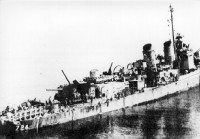 |
On February 21, 1945, the fight for the small island of Iwo Jima was entering its third day. Featuring less than 10 square miles of black volcanic residue, Iwo’s main lookout point consisted of Mount Suribachi, from where enemy artillery pieces could shell just about any point on the island. The task of taking Suribachi fell to Col. Harry Liversedge’s 28th Marines, and his assualt got underway shortly after 8:00am. But before they jumped off, the 550′ peak was treated to a pounding from naval gunfire as well as bombs and cannon fire from the fleet’s carrier-based aircraft.
The U.S. Navy did a lot of grunt work during the month-long battle. And while the 3rd, 4th, and 5th Marine Divisions had the toughest job (capturing the island and its three vital airfields), the Navy played a tremendous supporting role in the successful completion of the mission.
But like the Marines, the Navy paid a price for its work.
As we well know, the Japanese kamikaze squadrons were an ever-present threat. Having been formed in late 1944, these one-way suicide missions featuring one pilot, one plane, and one bomb, sought to wreak havoc among the advancing American vanguard. And while they never achieved the “one man, one ship” success their mantra sought, they were a deadly foe nonetheless.
And on the day the conquest of Suribachi began, the kamikazes came out to fight and die. As the afternoon headed towards evening, attacks from Hachijo Jima succeeded in breaking through the pickets and hitting the USS Saratoga. The long-lived carrier, one of the very first battlecruiser conversions, nearly met her end on this day, as she was hit by four kamikazes. Two hours later, as crews fought to save the ship, five more enemy planes bored in, and one planted a bomb on the forward flight deck. The fact that she was saved from sinking was a testament to the ability of the crews to successfully overcome the fires and damage that should have sunk her. But the attacks cost more than 300 casualties, including 123 killed.
The Bismarck Sea was not so fortunate. The Casablanca-class carrier was hit by just two kamikazes, but both were hit critical sections of the 10,000-ton escort carrier. The first penetrated the hangar deck and exploded in the ammunition magazines, causing extensive damage and powerful fires. The second, which struck just as crews were getting a handle on the situation, destroyed the fire fighting water distribution system, which meant it was impossible to put out the remaining fires. Three hours later, the Bismarck Sea slipped beneath the waves, taking 318 men with her.
The Bismarck Sea has the unfortunate distinction of being the last carrier of any kind sunk by a kamikaze during the War. The power of Japan’s kamikazes was not in their effectiveness – while they sank numerous vessels, they wasted thousands of lives and thousands of aircraft in a completely futile attempt to stave off inevitable defeat – but rather in their terrifying randomness.
Recommended Reading: The War in the Pacific





